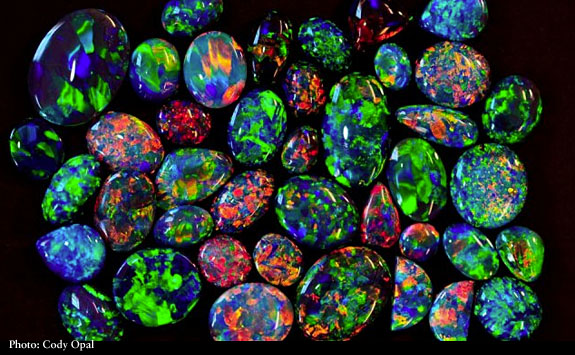June 25th, 2013
New research matching the geology of Mars with that of Australia’s Red Center sheds new light on why 95% of the Earth’s opals come from Down Under and how the Red Planet is likely a rich source of the colorful, fiery gemstone.

The findings, which were published in the Australian Journal of Earth Sciences, reveal that opals started forming in a vast, but dying, inland sea about 100 million years ago during “an extraordinary episode of acidic weathering.”
“Before this, we did not know [opal's] origin, why it forms at such shallow depths or why it can be found in central Australia and almost nowhere else on Earth,” said lead researcher Professor Patrice Rey of the University of Sydney.
Between 100 million and 97 million years ago, a vast sea that covered 60% of Australia began retreating. As the sea regressed, a rare episode of acidic weather was taking place, exposing pyrite minerals and releasing sulphuric acid. As the surface of the basin dried further and cracked, silica-rich gel became trapped in the veins of the rock. Over time, the silica solidified to form opals.

Central Australia is believed to be the only place on Earth where acidic weathering of this scale has ever taken place. However, the same conditions were documented on the surface of Mars in 2008.

"If you look at Mars and the Red Center [of Australia], they share similar characteristics," said Patrice. "Similar rocks went through similar weathering processes, so potentially precious opals might exist there." Interestingly, Australia’s Red Center, an arid area known for its bright rust-colored soil, could easily be mistaken for an outpost of Mars.
So far, only poor-quality opals have been identified on the surface of Mars. They were discovered in 2008 by NASA’s Mars Reconnaissance Orbiter using a spectroscope.

The findings, which were published in the Australian Journal of Earth Sciences, reveal that opals started forming in a vast, but dying, inland sea about 100 million years ago during “an extraordinary episode of acidic weathering.”
“Before this, we did not know [opal's] origin, why it forms at such shallow depths or why it can be found in central Australia and almost nowhere else on Earth,” said lead researcher Professor Patrice Rey of the University of Sydney.
Between 100 million and 97 million years ago, a vast sea that covered 60% of Australia began retreating. As the sea regressed, a rare episode of acidic weather was taking place, exposing pyrite minerals and releasing sulphuric acid. As the surface of the basin dried further and cracked, silica-rich gel became trapped in the veins of the rock. Over time, the silica solidified to form opals.

Central Australia is believed to be the only place on Earth where acidic weathering of this scale has ever taken place. However, the same conditions were documented on the surface of Mars in 2008.

"If you look at Mars and the Red Center [of Australia], they share similar characteristics," said Patrice. "Similar rocks went through similar weathering processes, so potentially precious opals might exist there." Interestingly, Australia’s Red Center, an arid area known for its bright rust-colored soil, could easily be mistaken for an outpost of Mars.
So far, only poor-quality opals have been identified on the surface of Mars. They were discovered in 2008 by NASA’s Mars Reconnaissance Orbiter using a spectroscope.


